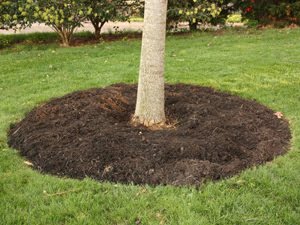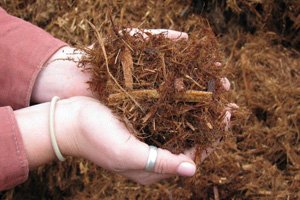The answer is always yes to mulch! It is a matter of how much and frequency that needs to be addressed. It is a common mistake by a lot of commercial landscapers to use mulch in excess which can be detrimental to your plants. Mulch is primarily used for the following reasons:
- Conserve water in root zone
- Cooling the root zone
- Nutritional break down
- Insect, pest and weed suppression
- Aesthetics
Your main concern is making sure your plants needs are met, which may mean you don’t need to mulch every year.
When do I Mulch?
A healthy layer of mulch can be applied at any time.
- Spring time- This is most commonly when people mulch because plants are being pruned and beds are being cleared of remaining debris left from last season.
- Summer- You can mulch in the summer as long as you do not apply “hot” mulch onto plants that may stress during this season. A light watering is recommended when mulching in the summer.
- Fall- Mulching in the late fall is a good way to put your beds to rest for the upcoming winter weather.
It is always best when you have new plantings, whenever that may be to mulch in order to help irrigate and retain moisture in their root zone.
How to Mulch
Generally we like to follow the Cornell Recommended Guidelines for mulching. This is weeding and clearing out the desired area first. Then apply mulch circularly about 3 to 4 inches deep around the tree or plant. Once much is laid down you want to pull the mulch slightly away from the base of the tree or plant creating a small circular depression.
Sometimes mulch can become hydrophobic, which means it will not let the natural rain water through and becomes very heavy. This is why it is a good idea every year to rake up and turn over the existing mulch, which will help crack open it’s “skin”. Some years you may not need to add a great deal of mulch, but instead just add a light covering of an inch or so in order to achieve ideal depth.
Types of Mulch
- Hardwood ground mulch- beneficial to landscape in the sense they have been decomposing for some time and there is a nitrogen cycle that is returning nutrients back to the soil.
- Arbor Mulch- Tree chipping mulch, which is not recommended at all times because the nitrogen cycle has not been completed. So sometimes it can do more harm than good, by pulling the nitrogen out of your plants. This is detrimental and can cause yellowing or light greening of plants which is called chlorosis.
- Ground wood- Colored mulch, which is not necessarily most beneficial. It is made from ground up wood byproducts which doesn’t fully complete the most important benefits of mulch.
When choosing mulch you want to make sure that it best suits your needs. Mulch that has been decomposing for some time and has completed the nitrogen cycle would be best. It will contain the highest benefit to your landscape, by breaking down and returning nutrients to the soil.





